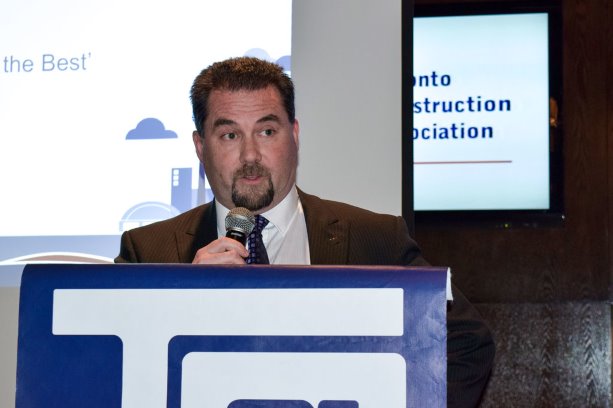Leaders past and present attending the Toronto Construction Association’s (TCA) Annual Meeting at Woodbine Racetrack on Jan. 28 affirmed that even with strong local construction growth recently and bullish predictions for the immediate future, now is not a time for complacency.
On the contrary, three TCA board members stressed, there is an urgency to address such crucial association needs as providing innovative programming to bolster TCA membership, boosting competitiveness among medium-sized and smaller firms and finding ways to enhance relationships with other stakeholders.
Because standing still, suggests TCA president John Mollenhauer, is an option that’s not only unproductive but it’s harmful to the association’s prospects. The TCA has to be aggressive in programming and marketing to take the next step forward, he said.
"Membership has been great," said Mollenhauer. "We were growing in a big way for awhile but growth has slowed down. In order to stay ahead of the curve we’ve got to keep changing, keep improving. If we treat everything we do as a dynamic process, and that is our culture, then we will prosper like our members will prosper, but if we don’t, it gets too easy to accept the status quo and that’s not good enough."
The TCA currently has about 2,200 members. Outgoing chairman Romeo Milano, interviewed before the meeting, echoed Mollenhauer in expressing his concern that without strong new programming that helps produce healthy membership numbers, the TCA risks losing relevance.
"The association business in Canada is changing, there is declining membership across the board in every association," said Milano. "And so our challenge is how we keep our existing membership engaged, how we give them the value-add that they feel they get from the TCA versus any other association in the country, and we have accomplished quite a bit in that regard."
Opportunities for dialogue within the organization and with decision-makers across the province have to be pursued aggressively, said incoming chairman Craig Lesurf, addressing the crowd.
"I look around the room and I see people from all facets of the community, which is great, it allows for interactive networking," said Lesurf. "Not all associations benefit from that. And that is one of the reasons it has profited and stayed strong over the years.
"One of my initiatives is to make sure we all talk more and that we all interact more, because I think that’s important."
Mollenhauer mentioned one beneficial TCA relationship as an example of how strong alliances can benefit TCA members.
"Infrastructure Ontario obviously procures a great deal of work each year, and partnering with the ORC (the former Ontario Realty Corporation, which merged with Infrastructure Ontario in 2011)…that adds another 3,500 to 4,000 projects per year, and the good news is Infrastructure Ontario consults with industry," he said. "So they create a dialogue about what’s working, changes that ought to be considered for the greater good."
Similarly, Mollenhauer said, the TCA needs to keep discussions flowing with the City of Toronto on policy to ensure, for example, that developers can take full advantage of the possibilities associated with potential new high-density nodes created by new infrastructure.
"Transit nodes should be high-density in terms of zoning to attract developers where it makes sense to develop higher-density residential and commercial," he said. "If the zoning isn’t staying current with all the new transit, then some of the benefits are lost.
"It (zoning) is lagging by a bunch."
Both the Ontario Chamber of Commerce and BuildForce Canada have issued forecasts that call for steady and broad growth across the construction sector in the Greater Toronto Area over the medium term — BuildForce sees strength until at least 2019.
Another TCA challenge, in the face of this positive forecast, said Mollenhauer, is to ensure that all types of members find a way to benefit.
"In volume terms the current superheated market is sustainable but that does not mean that everyone associated with construction will prosper," he said. "On the contrary, smaller firms continue to find bidwork intensely competitive in Ontario and I don’t see that changing any time soon."
Work is being procured in a variety of ways these days, Mollenhauer said. With consortiums playing such a large role, it is incumbent on the TCA to help all of its members participate in all procurement scenarios, he said.
"We are seeing tremendous innovation from consortium teams, from the builders, from the generals," he said. "I would like to see that down the food chain. And we are starting to see it in mechanical, electric, structural, and it is spreading. Roofers and others are getting more innovative. And the more innovative you are, the less likely it’s just about price."











Recent Comments
comments for this post are closed